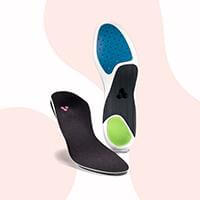Achilles tendon – How to relieve the pain

The Achilles tendon is the body’s largest and strongest ligament. It is an elastic band between the calf muscle and heel bone. The Achilles tendon is important because it allows us to bend and stretch the foot. It is therefore very important for mobility. With each step we take, the Achilles tendon carries our full weight. It can withstand enormous force even though it is only about 0.5 cm thick.
Depending on the speed of movement, stride length, underlay and whether the weight is carried or pulled, an Achilles tendon may be exposed to forces many times greater than the person’s body weight – in fact, anything up to ten times body weight!
An inflammation in the Achilles tendon that connects the calf muscles and heel bone. The Achilles tendon is the body’s largest and strongest ligament.
An inflammation of the Achilles tendon is normally a strain injury related to running or other sport as a result of activities that overload the Achilles tendon and calf muscles.
In most cases, an inflamed Achilles tendon can be treated relatively simply at home. Persistent care will often be required to prevent a recurrence of the inflammation.
In severe cases, the Achilles tendon can tear or rupture and require surgery to repair the damaged ligament tissue.
If you have an inflamed or overstretched Achilles tendon, the healing process is often painful and can take months. Read here what causes pain and how you can get relief:
- Symptoms
- Cause(s)
- Treatment and prevention
- Align Footwear
What are the symptoms of inflammation in the Achilles tendon?
The signs of an inflammation in the Achilles tendon tend to vary. The degree of pain is also individual.
The following symptoms may indicate that you have an inflamed Achilles tendon:
- Tenderness or mild pain at the back of the leg and across the heel after running or other sports activities.
- Episodes of more severe pain in connection with longer runs or intensive training (e.g. sprinting).
- Tenderness or stiffness – especially in the morning, which improves in response to gentle activity
- A little swelling or lump on the Achilles tendon
- Your Achilles tendon “squeaks” as it moves
- Weakness or heaviness in the lower leg.
If you have an inflammation, it is important that you rest. If you do not rest, an ordinary inflammation can develop into a chronic condition.
The pain may shift from directly on the Achilles tendon or the bone to one or both sides of the Achilles tendon. The location of the pain depends, for example, on how your foot was strained and what kind of movement triggered the strain.
What causes inflammation of the Achilles tendon?
A number of things can cause a tender Achilles tendon. Read here about the usual causes:
Repetitive strain on the calf muscle combined with a lack of strength/rehabilitation or restitution can cause calf strain, which in turn may cause pain in the Achilles tendon.
The following factors can be either the specific cause or a contributory factor in an Achilles tendon injury:
Over-exertion – e.g. if you run further or faster than normal.
Tension – e.g. short or taut Achilles tendons or calf muscles.
Legs of different lengths.
Unsuitable footwear – if shoes are too big or too small, worn out, etc.
An Achilles strain due to a sudden movement, fall or similar.
In many cases, a pause may be sufficient to bring about an improvement. However, a pause seldom resolves the cause of tenderness or pain in or around the Achilles tendon. If you wish to fight the causes of your Achilles injury, your whole body should be checked. Irritation or pain the Achilles tendon is often a sign that one or more of your joints move(s) incorrectly. The cause of misalignment should be identified and treated before you continue training. You cannot run from an inflamed Achilles tendon and it is crucial that you do not ignore pain. Pain is a sign that there is something wrong with your body. If you ignore its warnings, the damage may become chronic. In a chronic injury, the tissue may need as much as 9-12 months to heal before it is ready to work again.
If you have been examined and the cause of your tender Achilles tendon is not inadequate flexibility, inappropriate running shoes may play a small role in your difficulties. If you have recently replaced one type of running shoes with another, the switch may slightly change the load on your calves. The change may cause irritation that in turn triggers an inflammation of the Achilles tendon. If you switch to a harder underlay, e.g. asphalt, when you run, the different shock may also have an effect.
Chronic inflammation of the Achilles tendon is a very common sports injury. If you do not follow your doctor’s advice, you risk the pain becoming chronic. Chronic inflammation of the Achilles tendon may be caused by any of the following:
- Tenderness/pain in the Achilles tendon can be excruciating. Many runners believe that they can continue to run and the pain will go away. This is a disastrous misconception. You should always react to the slightest sign of tenderness in the Achilles tendon – and rest.
- The Achilles tendon heals slowly and with difficulty because it has a poor supply of blood. The lengthy healing process means that the Achilles tendon stiffens and becomes less elastic due to the formation of scar tissue – which makes the Achilles tendon even more susceptible to injuries due to running. It is a downward spiral.
- The Achilles tendon also becomes less elastic with age so elderly runners often suffer from an inflamed Achilles tendon.

How to treat and prevent inflammation and injury of the Achilles tendon.
To prevent injury to the Achilles tendon, we advise you to:
- Stay in good shape
- Warm up before activity
- Stretch out after activity
- Do exercises to strengthen your Achilles tendon
You should initially focus on reducing training intensity. After running, you can put an ice bag on your Achilles tendon. You may not necessarily have to stop running but you should shift focus to milder training. You must not overload or stress your Achilles tendon.
Moreover, it is important to avoid over-stretching an inflamed Achilles tendon. A gentle stretch can help to improve the flow of blood whereas excessive stretching of the tendon will overload/stress an Achilles tendon that is already tender and swollen.
Remember: NEVER stretch an injured tendon so much that it is painful.
Avoid provoking pain in your Achilles tendon. You are well advised to wear insoles. In many cases, insoles will relieve pressure on your Achilles tendon. You should also avoid walking on bare feet.
How to treat recurrent tenderness in the Achilles tendon.
To promote healing/restitution, place an ice bag on the tender spot for 10-15 minutes. It is often a good idea to massage the calf muscle and stretch well before and after exercise. Wear shoes that provide support to the weak part of your foot. Buy insoles to relieve pressure.
Listen to your body! If you continue to overload your Achilles tendon despite the pain, you may in time end up with a ruptured Achilles tendon.
Inflamed and damaged ligament tissue takes 9-12 months to heal. If your Achilles tendon is inflamed or ruptured, the healing process is a long one.
You can do the following:
- Massage the muscles of the calf, foot, rear thigh, buttocks and back.
- Slow rehabilitation and strengthening of the Achilles tendon. Your physiotherapist or doctor can give you exercises to do at home.
- At the same time, insoles can relieve and correct your foot position.
What can Align Footwear® do?
First and foremost, an insole provides your feet with optimal support and shock absorption. The insole focuses on correcting foot position to reduce the risk and prevent injury. Performance often also improves.
An insole often provides arch support. There are many variants and brands on the market. Each addresses the various problems and needs that can occur if you have an active lifestyle and engage in sports activities on a regular basis. Most types of insoles focus on the arch. Many feature a wedge or cushion that supports the arch. Align Footwear’s approach to foot health is new. We choose not to place an artificial support under the forefoot, e.g. a forefoot compression pad. This was a common solution in the past. To our way of thinking, insoles should be designed to control the ankle, optimise physical potential and give all the muscles under our feet room to move as nature intended. If you wear insoles with compression pads, your foot is restrained and the foot muscles prevented from exercising and becoming stronger.
Align Footwear® insoles have good shock absorbing properties. If you are an active runner, jumper or move faster or more often than others, our insoles relieve the strain on your muscles, ligaments and joints.
If you feel pain in your feet, we recommend that you seek medical attention. A doctor or physiotherapist can explain more about how your foot is constructed. If you have ill-fitting shoes, they will squeeze your feet and may cause discomfort and even pain not only in your feet, but also in your ankles, knees and hips. Failure to relieve pressure on your joints, muscles and feet or adequately absorb pressure may ultimately cause permanent damage and chronic pain.
Align Footwear® insoles provide effective shock absorption.
In addition to shock absorption, some brands of insoles offer additional support in particularly if your running style is overpronating or supinating. If you have an arch or heel (plantar fasciitis) injury, an insole may help to give your foot the support it needs. It relieves pressure on particularly vulnerable places.
Align Footwear® insoles provide:
- Better body alignment
- Better working conditions for the muscles of the foot. You will find your strength improves here.
- Less strain on joint cartilage, ligaments, tendons and muscles
- Fewer injuries
- Effective, more appropriate patterns of movement
- Better shock absorption
- Less physical fatigue
For optimal performance, Align Footwear® insoles have three world-patented points that optimise control, stability and contact between your feet and the underlay.
Align Footwear® insoles work with your foot and create the best possible working conditions for the muscles and ligaments of the lower leg, ankle and foot, and ensure that they are all used as naturally as possible in connection with foot movement. Among other factors, the insoles are the result of intensive biomechanics research into the kinetic chain. Our research has produced new knowledge about how pressure is distributed across the foot sole in the different foot types (those that pronate, are neutral and supinate).
Our insoles strengthen foot muscles and therefore optimise progress in sports training. The insoles focus on correcting heel position so that the knees, hips and shoulders are also aligned in a natural, balanced position. The layered design of our insoles means that there are different degrees of hardness in the outer and middle sole of the shoe to optimise contact with the underlay, stabilising and optimally aligning the body. You therefore have the best conditions for performing at your best and therefore good opportunities to achieve training goals.

60-day Refund Policy
Full satisfaction or money back

You didn’t find an answer?
Call +45 22 633 633
or contact@alignfootwear.eu


